Our approach to sustainability
Aker BP takes global climate challenges seriously and works to reduce the company’s environmental footprint. Our emissions are less than one-third of the average in the global industry, and below the average for operators on the Norwegian continental shelf. Our GHG intensity target is set at below 4 kg CO2e per barrel of oil equivalent.
Our strategy to meet the world’s growing energy needs while also contributing to reducing global emissions is threefold: We aim to produce the cleanest oil and gas, and at the same time generate revenue that can be used to finance the energy transition and build a sustainable future.
Aker BP creates substantial long-term value from the natural resources available to us – thus enabling society to restructure the economy and introduce measures that can halt climate change. By reducing emissions from our activities, we contribute to a reduced global footprint. We also contribute knowledge, data and experience to new industries, creating growth and improvement beyond our own business.

United Nations Sustainable Development Goals
Aker BP’s core business of delivering energy to our customers and the way we operate contribute directly to and support several of the United Nations Sustainable Development Goals (SDG). Some of our main contributions are outlined in our sustainability report and illustrated below.
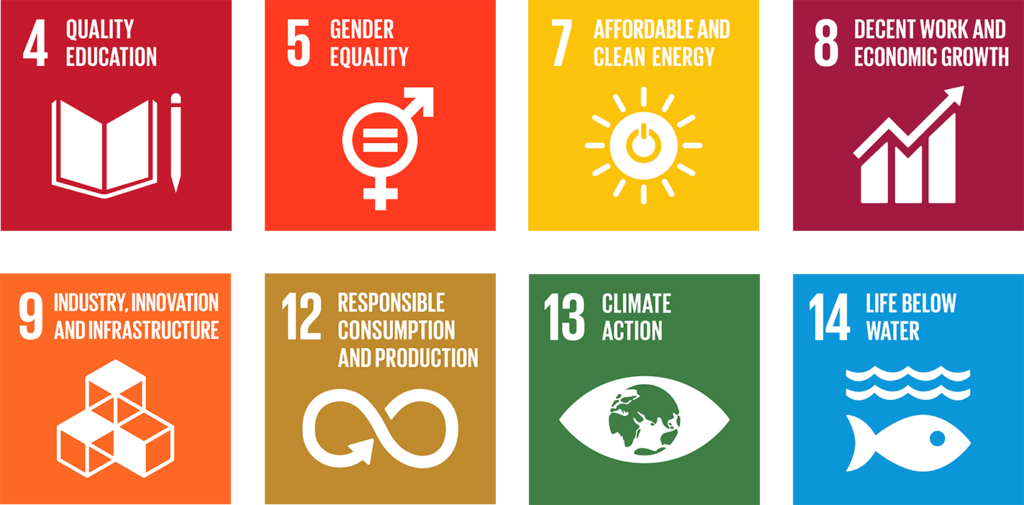
Human rights
Aker BP’s commitments to respect fundamental human rights and decent working conditions are set forth in our Code of Conduct and are further reiterated in our Human Rights policy.
To continuously improve our human rights efforts and avoid negative impact on fundamental human rights and decent working conditions, we conduct human rights due diligence in order to identify risks related to our operations.
Aker BP operates in a low-risk environment with respect to human rights as our main activities are in Norway, however we are mindful of the potential negative impacts from our operations and in our supply chain.
Governance policies
Climate
Aker BP acknowledges the conclusions from the Intergovernmental Panel on Climate Change (IPCC), and we are committed to take responsibility for the company’s carbon footprint.
We are convinced that we can and will be part of the solution needed to meet one of the biggest challenges of our time — climate change.
Towards 2030, global greenhouse gas emissions must be halved to succeed in halting global climate change. On the same horizon, we see that oil and gas will account for almost 50 per cent of the global energy mix in 2040, according to International Energy Agency (IEA) projections in the Sustainable Development Scenario. This scenario is fully aligned with the Paris Agreement on climate change.
By 2050, our gross Scope 1 and Scope 2 GHG emissions will be close to zero. This will be achieved through our investments in electrification and energy efficiency, as well as portfolio management. Read more about our approach to decarbonise our business in our decarbonisation plan.
Climate objectives and actions are formally embedded into Aker BP’s strategy and decision-making. The Board of Directors has ownership of climate-related objectives in Aker BP’s climate strategy, and reviews and guides the major action plans related to investment decisions for climate initiatives.
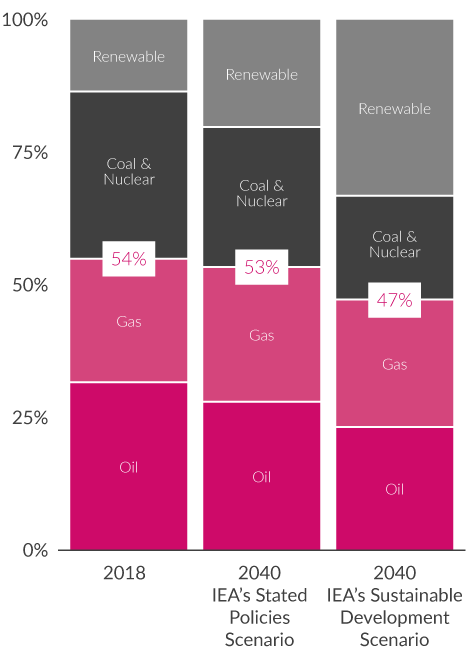
Decarbonisation plan
-
PDF – 1.19 MB
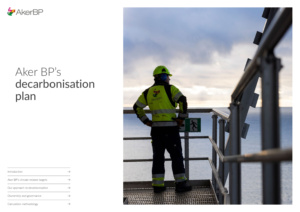
Environment policies
Environmental impact
Aker BP understands the environmental challenges presented by our activities and industry at large. Protecting the environment is and always has been a key part of sustainability work in Aker BP and we continuously work to reduce our environmental footprint. This work is guided by an environmental management system based on the principles of ISO 14001, and environmental management is integrated throughout the value chain of our fields.
Our Health, Safety, Security, Environment and Quality (HSSEQ) policy describes how to carry out our operations and our key environmental performance indicators guide our performance in a sustainable direction.
Our most significant environmental aspects originate from discharges to sea, emissions to air, waste, energy consumption and spills, and how these aspects affect biodiversity. We aim for an environmental impact that is as low as reasonably possible, through including use of best available techniques (BAT) and following NORSOK standard S-003 environmental care.
Key environmental performance indicators with corresponding targets, for instance for oil concentration of discharges to sea, CO2 emissions, flaring volume and produced water re-injection percentage, are defined at a company level and within each business unit.
Environment policies
Biodiversity
Aker BP’s exploration and production operations are concentrated in marine surroundings and we work efficiently to protect and conserve the related ecosystems and species within, thus safeguarding genetic biodiversity.
Activities in these areas are risk-assessed and monitored with regard to protection of sensitive benthic fauna and corals, coastal habitats, fish spawning and seabird breeding and feeding grounds.
Water and effluents
Aker BP’s operations are not located in water-stressed environments. All our operations are located on the Norwegian continental shelf, and freshwater usage is limited. Seawater is lifted and used for our operations such as cooling, pressure support for the reservoir and to generate fresh water offshore.
Our approach to generation and handling of effluents seeks the lowest possible environmental impact, with the following order of priority:
- Preventing occurrence
- Reuse/recycling/reinjection
- Reduction
- Treatment and disposal/discharge
Use of fresh water is limited, and mainly used at our supply vessels and in conjunction with drilling operations.
Data for consumption of fresh water from public sources are available in
this document.
Waste
To achieve the lowest possible environmental impact, we believe that generating less waste and improving resource utilisation is the most effective strategy.
Aker BP’s approach follows this order of priority:
- Prevention
- Minimisation
- Reuse
- Recycling
- Recovery
- Disposal
Aker BP’s waste handling procedures and processes comply with all relevant regulations concerning sorting, storage, classification, labelling, transportation and reporting. Waste management plans have been developed for all assets to ensure optimal resource utilisation and to support sustainable waste practices.
Waste audits are included in HSSEQ verifications, as well as in contractor audits and site verifications. We provide training for our employees, covering best practices in waste management.
Aker BP has several projects and initiatives aimed at diverting waste from landfill and promoting the reuse of materials and the recycling of waste. We prioritise our efforts based on the largest waste streams, with a particular focus on drilling-related waste, where prevention and minimisation are key.
By reusing materials and recycling waste, we reduce our environmental footprint and contribute to a more sustainable future.
Oil spill response
History teaches us that oil spills can and do occur in our industry. Aker BP’s robust oil spill response includes trained personnel that work tirelessly to ensure sound preparations for and mitigation of possible oil spills. Risk assessments are performed, and emergency preparedness plans specifically for oil spills are in place.
Aker BP has participated actively in the Norwegian Clean Seas Association for Operating Companies (NOFO) since 2001. They are specially trained to manage oil spill response operations and assume a central role with regard to mitigation measures and oil spill recovery at sea. We work together with NOFO to ensure that our oil spill contingency measures are dimensioned for our needs, making sure that we are prepared at all times.
Circular economy
Aker BP shall implement circular economy initiatives along the entire value chain, both within the company and through supplier cooperation. We shall promote circular economy in processes and encourage sustainable consumption in our operations. We shall aim for reduced resource use and waste prevention, keeping resources in the economy for as long as possible.
Aker BP acknowledges the expectations towards a circular economy from regulators and other stakeholders. Our Circular Economy model emphasizes sustainable production and consumption, allowing us to increase resource efficiency and reduce waste generation.
Environment policies
Safe operations
A license to operate on the Norwegian continental shelf implies compliance with strict Health, Safety, Security and Environmental requirements from the Norwegian authorities.
Aker BP strives to ensure that all operations, drilling campaigns and projects are carried out under the highest HSSE standards. Our HSSEQ policy describes the standards and expectations to ensure that Aker BP is a safe workplace for both our employees and our contractors.
Social policies
Health and safety
Aker BP acknowledges that risks will always be present during our exploration and production activities. We see it as our responsibility to reduce this risk to as low as reasonably possible, to avoid that our activities have adverse effects on people, the environment, or financial assets. Identifying risk and most particularly, understanding risk are necessary to prevent accidents and to ensure adequate emergency preparedness and reduce uncertainty.
Our overall HSSE performance displays a positive trend. However, to meet our ambition of no harm to people we maintain our continuous efforts to seek improvements in our HSSE culture and management practices.
We have implemented a set of Life-Saving Rules from the International Association of Oil & Gas Producers. The “9 Life-Saving Rules” represent industry-wide best practice in preventive HSSE efforts.
Aker BP provides a set of both occupational and non-occupational health services to prevent, discover and monitor work-related health risks. Employees also receive non-occupational health services related to personal health, physical therapy and health-promoting services such as support for increased physical activity, dietary advice and stress management.
Social policies
Security
Aker BP takes a risk-based approach to how it conducts its business. To manage risks appropriately, the company must also account for risks that originate when malicious actors intentionally try to harm its interests. We call these “security risks” including cyber risk.
The purpose of security is to protect Aker BP’s material and immaterial assets from malicious actors and unintentional security incidents.
Audit and Risk Committee nominated on behalf of the board, oversee security with particular focus on cyber-security risk as part of their overall accountability towards risk governance and specific risks communicated through the Aker BP enterprise risk process.
The SVP HSSEQ, on behalf of the administration (Executive Management Team), is the overarching subject matter accountable for Security in Aker BP. The VP Security oversees Aker BP’s holistic security and is responsible for governing Personnel and Physical security. The Chief Cyber Security Officer is responsible for governing Cyber security. The VP Security and the Chief Cyber Security Officer coordinate company-wide security risk management and governance.
Deciding and funding implementation of security barriers and security controls according to governance and risk, is the responsibility of each business unit according to financial authorization matrix.
Social policies
Emergency preparedness
Aker BP has a robust and efficient emergency preparedness organisation. In the event of an unwanted incident, our most important tasks are to save lives and to minimise damage to the environment and assets.
The emergency preparedness organisation regularly undergoes training and conducts exercises to ensure it is prepared to handle situations that may occur.
We work closely with partners and other emergency response organisations to ensure a shared understanding of the emergency response plans, responsibilities and priorities. We exchange knowledge and experiences, because well-functioning emergency preparedness is in everyone’s interest.
Social policies
Sustainability reporting
Sustainability reports
-
PDF – 13.3 MB

-
PDF – 11.8 MB
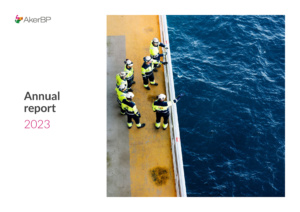
-
PDF – 11.7 MB
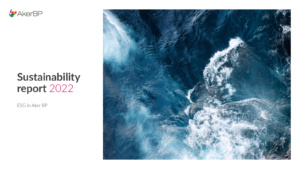
-
PDF – 15.3 MB
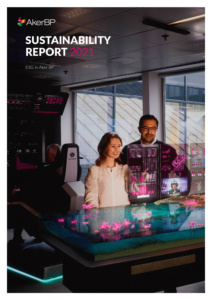
-
PDF – 10.3 MB
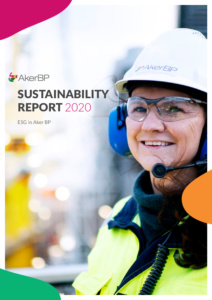
-
PDF – 9.8 MB

-
PDF – 4.08 MB
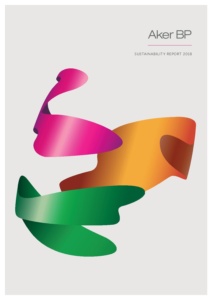
-
PDF – 1.25 MB
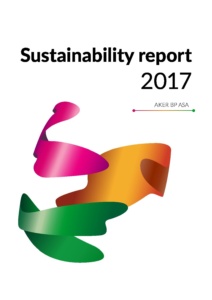
CDP Climate
Aker BP participates in CDP (formerly the Carbon Disclosure Project). CDP is a not-for-profit charity that runs a global disclosure system for the benefit of society, investors, companies, cities and countries. Aker BP contributes to increased disclosure on climate as well as better access to information regarding how we work.
-
PDF – 1.65 MB
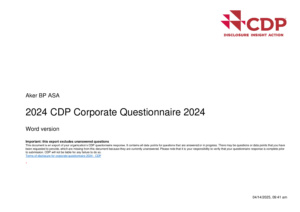
-
PDF – 1.64 MB
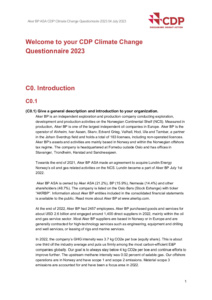
-
PDF – 738 KB
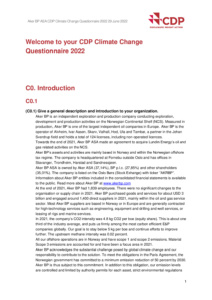
-
PDF – 34.6 MB
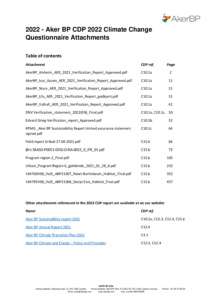
-
PDF – 646 KB
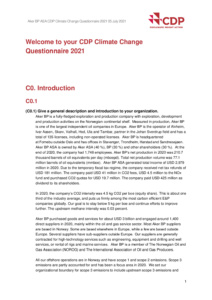
-
PDF – 620 KB
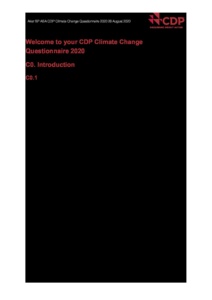
-
PDF – 608 KB
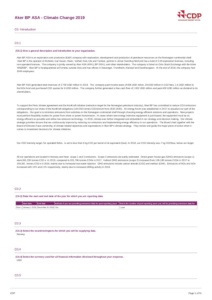
-
PDF – 570 KB
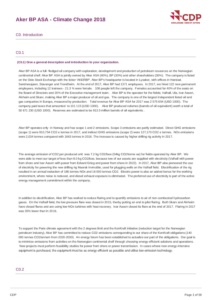
-
PDF – 413 KB
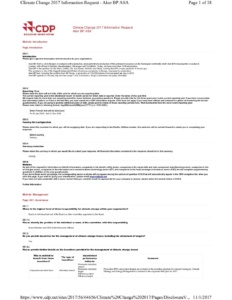
Sustainability data
In order to be in line with the GHG Protocol, all historical climate- and energy-related data have been updated to reflect the integration of Lundin Energy Norway. For all other environmental data, Edvard Grieg data is included as of July 2022, following the acquisition of Lundin Energy Norway.
E1 Climate change
| Operational control | Equity share | ||||||
|---|---|---|---|---|---|---|---|
| Energy consumption and mix | Unit | 2024 | 2023 | 2022 | 2021 | 2024 | |
| Total energy consumption | Total energy consumption | MWh | 4,407,016 | 4,710,143 | 5,084,933 | 5,585,039 | 2,638,327 |
| Total self-generated power | MWh | 3,446,723 | 3,826,632 | 4,667,789 | 5,168,038 | 1,587,996 | |
| Total power from grid | MWh | 960,293 | 883,511 | 417,144 | 417,001 | 1,050,331 | |
| Non-renewable energy use | Fuel consumption from coal and coal products | MWh | – | – | – | – | – |
| Fuel consumption from crude oil and petroleum products | MWh | 546,610 | 506,868 | 420,959 | 667,720 | 358,626 | |
| Fuel consumption from natural gas | MWh | 2,900,112 | 3,318,876 | 4,246,830 | 4,500,318 | 1,229,369 | |
| Fuel consumption from other fossil sources | MWh | – | – | – | – | – | |
| Consumption of purchased or acquired electricity, heat, steam and cooling from fossil sources | MWh | 798,446 | 734,932 | 292,001 | 261,043 | 873,309 | |
| Total fossil energy consumption | MWh | 4,245,169 | 4,560,676 | 4,959,790 | 5,429,080 | 2,461,305 | |
| Share of fossil sources in total energy consumption | % | 96.3% | 96,8% | 97,5% | 97,2% | 93,3% | |
| Renewable energy use | Consumption from nuclear sources | MWh | 100,051 | 91,977 | 66,743 | 94,659 | 109,432 |
| Share of consumption from nuclear sources in total energy consumption | % | 2.3% | 2.0% | 1.3% | 1.7% | 4.1% | |
| Fuel consumption for renewable sources, including biomass (also comprising industrial and municipal waste of biologic origin, biogas, renewable hydrogen, etc.) | MWh | – | – | – | – | – | |
| Consumption of purchased or acquired electricity, heat, steam and cooling from renewable sources | MWh | 61,796 | 56,601 | 58,400 | 61,299 | 67,590 | |
| The consumption of self generated non-fuel renewable energy | MWh | – | – | – | – | – | |
| Total renewable energy consumption | MWh | 61,796 | 56,601 | 58,400 | 61,299 | 67,590 | |
| Share of renewable sources in total energy consumption | % | 1.0% | 1.2% | 1.1% | 1.1% | 2.6% | |
| Operational control | Equity share | ||||||
|---|---|---|---|---|---|---|---|
| GHG emissions | Unit | 2024 | 2023 | 2022 | 2021 | 2024 | |
| Scope 1 GHG emissions | Gross scope 1 GHG emissions | 1000 t CO₂e | 838 | 906 | 1066 | 1187 | 405 |
| CO₂ (carbon dioxide) | 1000 t CO₂e | 806 | 878 | 1033 | 1148 | 383 | |
| CH₄ (methane) | 1000 t CO₂e | 29 | 26 | 31 | 37 | 21 | |
| N₂O (nitrous oxide) | 1000 t CO₂e | 3 | 2 | 2 | 2 | 2 | |
| Scope 1 GHG emissions – by source | Flaring and well testing | 1000 t CO₂e | 54 | 96 | 71 | 77 | 32 |
| Venting and fugitive emissions | 1000 t CO₂e | 15 | 21 | 13 | 17 | 12 | |
| Fuel combustion | 1000 t CO₂e | 759 | 783 | 974 | 1081 | 355 | |
| Loading of hydrocarbons | 1000 t CO₂e | 10 | 7 | 8 | 11 | 7 | |
| Lost production | Flared hydrocarbons | million Sm³ | 18.5 | 30.8 | 23.2 | 26.0 | 10 |
| Continuously flared hydrocarbons | million Sm³ | – | – | – | – | – | |
| Combusted hydrocarbons | million Sm³ | 267.6 | 284.0 | 359.1 | 372.3 | 111 | |
| Vented hydrocarbons | million Sm³ | 0.2 | 0.4 | 0.3 | 0.4 | <1 | |
| Percentage of scope 1 GHG emissions from regulated emission trading schemes | % | 93% | 97% | 95% | 96% | 94% | |
| Scope 2 GHG emissions | Gross location-based scope 2 GHG emissions | 1000 t CO₂e | 14 | 17 | 8 | 5 | 16 |
| Gross market-based scope 2 GHG emissions | 1000 t CO₂e | 575 | 444 | 204 | 169 | 629 | |
| Scope 3 GHG emissions | Total gross indirect (scope 3) GHG emissions | 1000 t CO₂e | 71,458 | 72,607 | 63,080 | 64,167 | 71,330 |
| Purchased goods and services | 1000 t CO₂e | 95 | 65 | 56 | 92 | 82 | |
| Purchased goods and services – cloud computing and data centre services | 1000 t CO₂e | NA | NA | NA | NA | – | |
| Capital goods | 1000 t CO₂e | 90 | 34 | 27 | 60 | 57 | |
| Fuel- and energy-related activities (not included in scope 1 or scope 2) | 1000 t CO₂e | 26 | 32 | 26 | 41 | 18 | |
| Upstream transportation and distribution | 1000 t CO₂e | 202 | 141 | 118 | 235 | 129 | |
| Waste generated in operations | 1000 t CO₂e | 1 | 3 | 3 | 3 | 1 | |
| Business travel | 1000 t CO₂e | 12 | 7 | 4 | 2 | 12 | |
| Employee commuting | 1000 t CO₂e | NA | NA | NA | NA | – | |
| Upstream leased assets | 1000 t CO₂e | NA | NA | NA | NA | – | |
| Downstream transportation and distribution* | 1000 t CO₂e | 191 | 21 | 29 | 26 | 191 | |
| Processing of sold products | 1000 t CO₂e | 4,668 | 4,935 | 4,155 | 4,628 | 4,668 | |
| Use of sold products | 1000 t CO₂e | 66,172 | 67,370 | 58,689 | 59,140 | 66,172 | |
| End-of-life treatment of sold products | 1000 t CO₂e | NA | NA | NA | NA | – | |
| Downstream leased assets | 1000 t CO₂e | NA | NA | NA | NA | – | |
| Franchises | 1000 t CO₂e | NA | NA | NA | NA | – | |
| Investment | 1000 t CO₂e | NA | NA | NA | NA | – | |
| Total GHG emissions | Total GHG emissions (location-based) | 1000 t CO₂e | 72,311 | 73,530 | 64,154 | 65,359 | 71,752 |
| Total GHG emissions (market-based) | 1000 t CO₂e | 72,872 | 73,957 | 64,350 | 65,523 | 72,365 | |
| Operational control | Equity share | ||||||
|---|---|---|---|---|---|---|---|
| Performance metrics | Unit | 2024 | 2023 | 2022 | 2021 | 2024 | |
| GHG emission intensities | Scope 1 and 2 GHG intensity | kg CO₂e/boe | 6 | 6 | 7 | 8 | 3 |
| Methane intensity | % | 0.02 | 0.01 | 0.02 | 0.03 | ND | |
| GHG emission per net revenue (market-based) | kg CO₂e/USD | ND | ND | ND | ND | 5,911 | |
| GHG emission per net revenue (location-based) | kg CO₂e/USD | ND | ND | ND | ND | 5,861 | |
| Energy emission intensity | Total energy consumption from activities in high climate impact sectors per net revenue from activities in high climate impact sectors | ND | ND | ND | ND | ||
E2 Pollution
| Operational control | Equity share | |||||
|---|---|---|---|---|---|---|
| Pollutants to air | Unit | 2024 | 2023 | 2022 | 2021 | 2024 |
| NOₓ | tonnes | 2,213 | 1,997 | 1,487 | 1,684 | 1,150 |
| SOₓ | tonnes | 43 | 44 | 27 | 39 | 32 |
| NmVOC | tonnes | 2,272 | 1,759 | 1,996 | 1,947 | 1,606 |
| Operational control | Equity share | |||||
|---|---|---|---|---|---|---|
| Pollutants to sea | Unit | 2024 | 2023 | 2022 | 2021 | 2024 |
| Phenols | kg | 42,304 | ND | ND | ND | 18,821 |
| Benzene | kg | 45,844 | ND | ND | ND | 23,386 |
| Ethylbenzene | kg | 1,110 | ND | ND | ND | 437 |
| m-Xylene | kg | 5,622 | ND | ND | ND | 2,535 |
| o-Xylene | kg | 3,735 | ND | ND | ND | 1,723 |
| p-Xylene | kg | 1,086 | ND | ND | ND | 427 |
| Toulene | kg | 30,524 | ND | ND | ND | 14,336 |
| Xylene | kg | 11,085 | ND | ND | ND | 5,059 |
| Arsenic (As) | kg | 23 | ND | ND | ND | 15 |
| Cadmium (Cd) | kg | 6 | ND | ND | ND | 2 |
| Lead (Pb) | kg | 63 | ND | ND | ND | 27 |
| Zinc (Zn) | kg | 4,294 | ND | ND | ND | 1,814 |
| Naphthalene | kg | 2,738 | ND | ND | ND | 1,240 |
| PAH | kg | 311 | ND | ND | ND | 156 |
| Operational control | Equity share | |||||
|---|---|---|---|---|---|---|
| Produced water balance | Unit | 2024 | 2023 | 2022 | 2021 | 2024 |
| Produced water generated | 1000m³ | 19,286 | 18,534 | 16,768 | 17,585 | ND |
| Produced water injected | 1000m³ | 12,893 | 12,918 | 10,898 | 10,712 | ND |
| Produced water discharged | 1000m³ | 6,045 | 5,395 | 5,726 | 6,767 | ND |
Substances of concern
| Operational control | Equity share | |||||||
|---|---|---|---|---|---|---|---|---|
| Hazard type | Hazard class | H-statements | Unit | 2024 | 2023 | 2022 | 2021 | 2024 |
| Health hazard* | Carcinogenicity | H350 and H351 | tonnes | ND | ND | ND | ND | 351 |
| Germ cell mutagenicity | H341 | tonnes | ND | ND | ND | ND | 11 | |
| Reproductive toxicity | H360, H360D, H360F and H360FD | tonnes | ND | ND | ND | ND | 311 | |
| Respiratory sensitisation | H334 | tonnes | ND | ND | ND | ND | 580 | |
| Skin sensitisation | H317 | tonnes | ND | ND | ND | ND | 5,817 | |
| Specific target organ toxicity – repeated exposure | H372 and H373 | tonnes | ND | ND | ND | ND | 5,274 | |
| Specific target organ toxicity – single exposure | H370 and H371 | tonnes | ND | ND | ND | ND | 314 | |
| Environmental hazard** | Hazardous to the aquatic environment – long term hazard | H410, H411 and H412 | tonnes | ND | ND | ND | ND | 990 |
** Data is reported on amounts discharged.
Substances of very high concern – used
| Operational control | Equity share | |||||
|---|---|---|---|---|---|---|
| CAS number | Unit | 2024 | 2023 | 2022 | 2021 | 2024 |
| 1303-96-4 | kg | ND | ND | ND | ND | 25 |
| 7439-92-1 | kg | ND | ND | ND | ND | 4 |
| 111-30-8 | kg | ND | ND | ND | ND | 258,533 |
| 625-45-6 | kg | ND | ND | ND | ND | 692 |
Substances of very high concern – discharged
| Operational control | Equity share | |||||
|---|---|---|---|---|---|---|
| CAS number | Unit | 2024 | 2023 | 2022 | 2021 | 2024 |
| 1303-96-4 | kg | ND | ND | ND | ND | 7 |
| 7439-92-1 | kg | ND | ND | ND | ND | – |
| 111-30-8 | kg | ND | ND | ND | ND | 8,634 |
| 625-45-6 | kg | ND | ND | ND | ND | 415 |
E3 Water and marine resources*
| Operational control | Equity share | |||||
|---|---|---|---|---|---|---|
| Water | Unit | 2024 | 2023 | 2022 | 2021 | 2024 |
| Freshwater withdrawal | m³ | 112,457 | 129,685 | 101,999 | 163,105 | ND |
E5 Resource use and circular economy
| Operational control | Equity share | |||||
|---|---|---|---|---|---|---|
| Waste | Unit | 2024 | 2023 | 2022 | 2021 | 2024 |
| Total waste generated | tonnes | 50,349 | 52,379 | 32,681 | 42,359 | 38,891 |
| Total weight hazardous waste generated | tonnes | 48,290 | 50,580 | 31,203 | 40,516 | 37,296 |
| Hazardous waste – reuse | tonnes | 265 | 112 | 352 | 506 | 455 |
| Hazardous waste – recycling | tonnes | 3,320 | 2,631 | 1,689 | 1,800 | 2,063 |
| Hazardous waste – other recovery (excluding reuse or recycling) * | tonnes | 0 | ND | ND | ND | 0 |
| Hazardous waste – incineration (energy recovery) | tonnes | 2,732 | 3,443 | 1,998 | 2,464 | 2,325 |
| Hazardous waste – landfill | tonnes | 17,933 | 17,422 | 10,313 | 13,442 | 13,338 |
| Hazardous waste – other disposal (discharge)** | tonnes | 24,042 | 26,972 | 16,851 | 22,304 | 19,116 |
| Total wight non-hazardous waste generated | tonnes | 2,059 | 1,800 | 1,478 | 1,843 | 1,594 |
| Non-hazardous waste – reuse | tonnes | 1 | 1 | 0 | 0 | 1 |
| Non-hazardous waste – recycling | tonnes | 727 | 784 | 695 | 1000 | 611 |
| Non-hazardous waste – other recovery (excluding reuse or recycling)* | tonnes | 0 | ND | ND | ND | 0 |
| Non-hazardous waste – incineration (energy recovery) | tonnes | 922 | 879 | 698 | 724 | 656 |
| Non-hazardous waste – landfill | tonnes | 409 | 135 | 84 | 119 | 326 |
| Non-hazardous waste – other disposal | tonnes | 0 | ND | ND | ND | 0 |
| Total amount of non-recycled waste*** | tonnes | 21,997 | 21,992 | 13,445 | 17,255 | 16,646 |
| Total percent of non-recycled waste *** | % | 84 | 87 | 85 | 86 | 84 |
| Total amount of radioactive waste (NORM, naturally occurring radioactive material) | tonnes | 31 | ND | ND | ND | 26 |
** Discharged fraction consists of wastewater treated onshore, mostly from drilling waste
*** Discharge of waste water treated onshore is not included
| Operational control | Equity share | |||||
|---|---|---|---|---|---|---|
| Waste diverted from/directed to disposal | Unit | 2024 | 2023 | 2022 | 2021 | 2024 |
| Total weight of waste diverted from disposal* | tonnes | 4,312 | 3,527 | 2,736 | 3,306 | 3,130 |
| Total weight of waste directed to disposal** | tonnes | 46,037 | 48,852 | 29,944 | 39,053 | 35,761 |
| Total weight of hazardous waste diverted from disposal* | tonnes | 3,585 | 3,453 | 596 | 2,772 | 2,518 |
| Total weight of hazardous waste directed to disposal** | tonnes | 44,705 | 47,126 | 30,607 | 37,744 | 34,779 |
| Total weight of non-hazardous waste diverted from disposal* | tonnes | 728 | 785 | 695 | 1000 | 612 |
| Total weight of non-hazardous waste directed to disposal** | tonnes | 1,331 | 1,014 | 782 | 843 | 982 |
** Waste directed to disposal includes waste that is discharged, sent to landfill or incineration with or without energy recovery
Environmental fines
| Unit | 2024 | 2023 | 2022 | 2021 | |
|---|---|---|---|---|---|
| Total monetary value of significant fines* | million NOK | 0 | 1 | 0 | 0 |
Health and safety
| Unit | 2024 | 2023 | 2022 | 2021 | |
|---|---|---|---|---|---|
| Fatalities – employees | cases | 0 | 0 | 0 | 0 |
| Fatalities – non-employees | cases | 0 | 0 | 0 | 0 |
| Fatalities – workers in the value chain | cases | 0 | 0 | 0 | 0 |
| Serious injuries – employees | cases | 1 | 2 | 0 | 2 |
| Serious injuries – non-employees | cases | 1 | 0 | 0 | 0 |
| Serious injuries – workers in the value chain | cases | 1 | 3 | 3 | 2 |
| Serious injury frequency – employees | million work hours | 0.2 | 0.5 | 0 | 0.6 |
| Serious injury frequency – non-employees | million work hours | 0.6 | 0 | 0 | 0 |
| Serious injury frequency – own workforce | million work hours | 0.3 | 0.4 | 0 | 0.5 |
| Serious injuriy frequency – workers in the value chain | million work hours | 0.3 | 0.9 | 1.2 | 0.7 |
| Serious injury frequency – total workforce | million work hours | 0.3 | 0.5 | 0.4 | 0.6 |
| Lost time injuries – employees | cases | 1 | 2 | 0 | 1 |
| Lost time injuries – non-employees | cases | 2 | 0 | 0 | 0 |
| Lost time injuries – workers in the value chain | cases | 6 | 8 | 5 | 6 |
| Lost time injury rate – employees | million work hours | 0.2 | 0.5 | 0 | 0.3 |
| Lost time injury rate – non-employees | million work hours | 1.2 | 0 | 0 | 0 |
| Lost time injury rate – own workforce | million work hours | 0.5 | 0.4 | 0 | 0.2 |
| Lost time injury rate – workers in the value chain | million work hours | 1.5 | 2.3 | 2 | 2.1 |
| Lost time injury rate – total workforce | million work hours | 0.9 | 1.1 | 0.7 | 1 |
| Medical treatment injuries – employees | cases | 2 | 2 | 2 | 4 |
| Medical treatment injuries – non-employees | cases | 1 | 0 | 0 | 0 |
| Medical treatment injuries – workers in the value chain | cases | 8 | 10 | 5 | 7 |
| Total recordable injury frequency – employees | million work hours | 0.6 | 0.9 | 0.6 | 1.6 |
| Total recordable injury frequency – non-employees | million work hours | 1.8 | 0 | 0 | 0 |
| Total recordable injury frequency – own workforce | million work hours | 0.9 | 0.7 | 0.4 | 1.2 |
| Total recordable injury frequency – workers in the value chain | million work hours | 3.5 | 5.3 | 4 | 4.6 |
| Total recordable injury frequency – total workforce | million work hours | 1.9 | 2.4 | 1.7 | 2.6 |
| Serious incidents | cases | 4 | 3 | 5 | 0 |
| Serious incident frequency | million work hours | 0.4 | 0.3 | 0.7 | 0 |
| Work hours – employees | million work hours | 4.6 | 4.3 | 3.5 | 3.1 |
| Work hours – non-employees | million work hours | 1.7 | 1.4 | 1 | 0.9 |
| Work hours – own workforce | million work hours | 6.3 | 5.7 | 4.5 | 4 |
| Work hours – workers in the value chain | million work hours | 4 | 3.4 | 2.5 | 2.8 |
| Work hours – total workforce | million work hours | 10.3 | 9.1 | 7 | 6.9 |
| Number of tier 1 process safety events | cases | 1 | 1 | 0 | 0 |
| Number of tier 2 process safety events | cases | 1 | 0 | 0 | 0 |
| Number of tier 1 and tier 2 process safety events | cases | 2 | 1 | 0 | 0 |